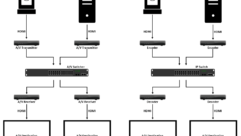
Fiber Fundamentals
Nov 21, 2011 10:00 PM,
By Bennett Liles
A refresher course on the latest in fiber-optic technology.

Light has the ability to carry 10,000 times more information than radio frequencies,
and the medium is impervious to electrical inductive noise.
So many forces are driving the fiber market up that its rapid rise threatens to outpace the general understanding of its basic workings on the part of many AV techs. Even in the broadcast realm, production engineers have found it useful to arm themselves with an occasional refresher course on the latest advances in fiber technology. As evidence of the ongoing three-way convergence of broadcast, AV, and IT, technical people can also value a basic understanding of the fast-changing world of fiber-optic AV transmission. So we present here a brief fiber primer and a snapshot of how the technology looks at present. But we’re using a fast shutter speed because fiber is on the move. Light has the ability to carry 10,000 times more information than radio frequencies, and the medium is impervious to electrical inductive noise. With fuel prices skyrocketing, fiber cable is also far lighter than ever more expensive copper — a significant difference in mobile applications. It’s a perfect storm of market growth, so let’s start with a look at the basic parts of a fiber system: transmitter, fiber cable, and receiver.

The transceiver forms a critical juncture in the transmission path where the signal is changed from electronic to optical and from optical back to electronic form.
TRANSMITTERS
Since these devices transmit light, they are also referred to as emitters. They convert electrical signals into modulated light beams. The typical fiber transmitters are light-emitting diodes (LEDs), vertical-cavity surface-emitting lasers (VCSELs), and laser diodes (LDs), and each has its advantages in specific applications. Generally, the most economical and linear in output for the amount of input current applied are LEDs, but they also have a relatively large emitting area that concentrates less light on the fiber. LEDs usually don’t need any extra temperature-stabilization circuits, and they are used primarily in short- or medium-range applications.
VCSELs have been around for more than a decade now, and one of their primaryadvantages is in production cost and testing. Produced on wafers and then cut to size, VCSELs emit light from the flat surface rather than from the thin edge, as is the case with the more traditional edge-emitting semiconductor lasers. This enables them to be tested before cutting the wafer, therefore providing a slightly lower production cost and predictable quality. Today all production VCSELs operate at 850nm. Fiber to the Home (FTTH) has made 1310nm F-P (Fabry-Perot) lasers very cheap as well so 1310nm on single mode fiber has also become very inexpensive.
With smaller emitting surfaces, laser diodes are far more efficient at getting more light into the fiber than are LEDs, and they are linear in light output for electrical input. However, they have a smaller range of operating temperatures in which they are stable, so LDs require more sophisticated circuitry to keep them within their stable operating range. This circuitry maintains the LD output at a constant average value by adjusting the bias current of the laser. All this adds to the cost, so LDs are used only for long-distance applications. Measured in wavelength, the three primary transmission windows in the fiber spectrum are 850nm, 1310nm, and 1550nm. LDs and LEDs are available in all three.
MODULATION
The three typical modulation methods for fiber-optic transmission are amplitude modulation, frequency modulation, and digital modulation. Each of these has various sub-flavors, but the primary difference is between analog and digital modulation. In the case of analog, a common method is referred to as intensity modulation wherein the brightness of the transmitted light beam is controlled according to the amount of current being fed to the emitter at any given moment. As the input current rises and falls, so does the brightness of the transmitted light beam. RF carriers may also be used to linearly modulate the light output. In digital modulation, there is only an on or off state for the light, but either the pulse width (meaning the time the light is on) or the pulse rate (meaning the frequency of the light flashes) can be used to carry information.
Fiber Fundamentals
Nov 21, 2011 10:00 PM,
By Bennett Liles
A refresher course on the latest in fiber-optic technology.

INTO THE GLASS
To couple the emitter’s output to the fiber with the maximum transfer of optical power, the transmitter’s emitting area may be pigtailed to the fiber or placed in close proximity to it, or a transfer lens may be used to better focus the light into the fiber. A pigtail is usually soldered or epoxied to the transmitter case for strain relief, and it exits the case as a fiber tube that is attached to the fiber core in the cable. Care must be taken in this installation to keep any trace of dirt, dust, or other contamination from the interface. In proximity connections, the optical power transferred is determined by four factors: the light source intensity, its emitting surface area, the acceptance angle of the fiber, and attenuation from Fresnel loss and contamination.
A key parameter in fiber transmitters is referred to as “transmitter launch power.” This refers to the amount of optical power that is launched into the fiber-optic cable. Higher optical power may be necessary to transmit over longer distances, but a representative example is -8dBm or 0.158mW. Normally, the higher the transmitter power, the more light is launched into the fiber. The smaller the ratio of the area of the emitting surface compared to that of the accepting core of the fiber, the more light is transferred. The acceptance angle of the fiber forms a cone with its center at the axis of the fiber. Any light that enters at an angle inside the cone will travel down the fiber. The sine of half the acceptance angle is referred to as the “numerical aperture,” which is the term often seen in the fiber specs. The loss that occurs at any glass-to-air interface is about 4 percent, and this is called Fresnel loss. Special coupling gels can be used to reduce this loss, but they do not eliminate it. As was mentioned earlier, contamination in the transmitter or fiber can add to the loss of optical power. Loss in fiber-optic cable also varies with the wavelength of the light used, but while attenuation in copper cable goes up with the frequency of the modulated signal, in fiber, the attenuation is the same for all modulation frequencies and bit rates.
THE FIBER-OPTIC CABLE

The comparison between light mode paths in multimode step index, multimode graded index, and single-mode fiber.
The cable consists of the ultra-pure glass core that transmits the light, the glass cladding surrounding the core, and a protective sheath. Between the sheath and the cladding is usually a layer of strengthening material such as Kevlar. The cladding reflects light hitting it at an angle back into the core; it does this due to its having a different refractive index than that of the core. Fiber-optic cable is described with two numbers, which correspond to the dimensions of the core and cladding, expressed in micrometers or 1/1000 of a millimeter, commonly called a micron. A common type is 62.5µm/125µm with a core of 62.5 microns and a cladding of 125 microns. Smaller-core fiber is normally used with laser-diode transmitters for long distances in telecommunication applications.
Fiber can be classified in several ways. Either it can be stepped index fiber, in which the difference in refractive index between the core and cladding causes the light to bounce off the cladding and continue down the core material, or it can be graded index, in which the cladding’s index of refraction gradually increases with distance from center of the core until it matches the index of the cladding so that light is curved rather than bounced back into the core. The other primary type differentiation in fiber-optic cable is called the mode. To keep things simple, you can think of the mode as the path of a single ray of light through the core. A wider core allows more modes of light, but because these bounce their way down the cable, they reach the receiver at slightly different times—a factor known as “modal dispersion,” which is specified in nanoseconds per kilometer (ns/km). This limits the highest frequency that can be transmitted and thus the bandwidth of the transmission. The smaller the core, the fewer modes can be transmitted and the higher the bandwidth of the transmitted signals. Multimode fiber is typified by higher core diameters (50μm-62.5μm) and lower bandwidth, while single-mode fiber has smaller core numbers (8μm-10μm) and higher bandwidth. The bandwidth of fiber cable also decreases with length, and loss along the line is measured in decibels just as with copper cable. The loss in bandwidth due to multimode cable length is called “modal bandwidth,” and it is expressed as the frequency in megahertz times the distance in kilometers. The higher the modal bandwidth figure, the better the performance of the system, all other factor being equal.
Fiber Fundamentals
Nov 21, 2011 10:00 PM,
By Bennett Liles
A refresher course on the latest in fiber-optic technology.

Most fiber-optic communication is sent on wavelengths that are above the visible light spectrum. As wavelength increases, frequency decreases.
Bend Insensitive Fiber-Optic Cable
While fiber is being pulled during installation, the bend radius should be greater than 20 times the cable diameter. After installation, under no tension, 10 times the cable diameter is OK because excessive bending also causes signal attenuation, although bend radius has been the source of ongoing improvement in newer fiber-optic cables. This “bend insensitive” fiberoptic cable introduced in 2009 uses a ring of lower index optical material called an “optical trench” to surround the core and reflect light loss back into it. The factors that affect bending loss are the fiber type (single mode or multimode), the core diameter, numerical aperture, transmission wavelength (longer wavelengths are more sensitive to stress), and cable design.
Fiber-optic cable is also classified as to the material of which it is made. Glass fiber-optic cable has a glass core and cladding, and it is the most widely used, but plastic-clad silica (PCS) offers less performance for less money. For home-theater applications where high loss and short-range capability is not a problem, plastic fiber has a plastic core and cladding. This is the most economical variety. PCS and plastic fiber also have fewer protective layers than glass fiber. The loss characteristic can vary from plastic at 300dB/km to single-mode glass at 0.2dB/km.
Receivers
Also known as detectors, the receiver in fiber-optic transmission is normally a PIN- or Avalanche-type photodiode mounted in a case similar to that used for the transmitter. These have a much larger sensitive detecting area than the emitting area of transmitters, so the stringent alignment precautions necessary on the sending end are usually not necessary on the receiving end. The size of the receiver, however, must be matched to the size of the fiber so as not to overload the detector’s high-gain amplifier and cause a distorted output. If the fiber is too small for the receiver, too little light will reach the detector, and the eventual signal-to-noise ratio will suffer. The signal originally received is tiny, and voltage converted from it has to be amplified in steps to make it useable. Most fiber-optic receivers employ an analog preamplifier followed by either an analog or digital output stage. This is normally followed by additional stages to boost the signal before it is fed into other equipment or transmitted over other media. The receiver sensitivity is another important parameter in the fiber-optic system; this is the minimum optical power that is required for the receiver circuitry to deliver the signal correctly. A typical receiver sensitivity figure is -28dBm or 0.00158mW.
Once the transmitter power, the loss on the line, the receiver sensitivity, and the signal-to-noise ratio that is required are known, the optical budget of the fiber system may be calculated. The optical budget, referenced to 1mW or 0dBm, is basically the difference between the transmitter power and the receiver sensitivity. This figure will represent the maximum loss that can be tolerated along the line for the system to work.
TRANSMISSION WINDOWS
As was mentioned previously, there are some standard windows in the fiber transmission spectrum and these exist between several large absorption areas. The general rule is: The higher the wavelength, the lower the attenuation. The original window that was used in fiber transmission was the 850nm region, which is known as the “first window.” It provides about a 3dB/km loss, and as longer wavelength signals came into use, they came into favor. The second window, at 1310nm, exhibits an attenuation of about 0.5dB/km; the third window, at 1550nm, offers a loss of 0.2dB/km. All these are located within the overall spectrum just above visible light in the infrared region, but some low-end, short-distance systems use the 660nm range in the visible light area. As one might expect, higher-wavelength systems provide better performance but at higher cost. The attenuation factor can, of course, be offset by the fiber-cable diameter. Once again, narrower cable means less optical attenuation. Multimode fiber operates at 850nm or 1300nm while singlemode fiber operates at 1310nm or 1550nm.
A number of methods have arisen for combining multiple signals onto one single-mode fiber, and this effort has been aided by the development of flat-spectrum fiber that eliminates the high-loss region around 1380nm. The technique of Coarse Wave Division Multiplexing (CWDM) can combine up to 18 separate signals on one single-mode fiber. When CWDM is used with systems providing up to eight separate video channels, a total of 144 video channels on one fiber are possible. An even more densely packed multiplexing scheme is Dense Wave Division Multiplexing (DWDM), in which up to 128 separate wavelengths can be simultaneously transmitted. DWDM systems are far more expensive than CDWM systems.
Fiber Fundamentals
Nov 21, 2011 10:00 PM,
By Bennett Liles
A refresher course on the latest in fiber-optic technology.
CHECKING AND TESTING
Fiber-optic cable is not perfect. With all its advantages in induced noise rejection, immunity to inductive eavesdropping, and being impervious to ground loops, it is especially vulnerable to contamination by dirt and other foreign matter at the junction points, as well as excessive bending. Optical power can be measured through a fiber-optic system with a light meter calibrated for the specific wavelengths used, and the condition of the cable can be checked with an instrument called an optical time-domain reflectometer (OTDR). This instrument contains a very precise timing mechanism that measures the length of time a signal takes to be sent down the fiber and return. Any imperfections or faults in the line can be located exactly by timing the pulse return and noting imperfections in the shape of the waveform.
The first step is to measure the output of the transmitter with the light meter and compare it to the specs. Then the light level at the receiving end of the fiber is measured and compared to the published receiver sensitivity figure. If the light level is above the receiver sensitivity, the system should perform correctly. If this is not the case, the receiver diode or the receiver circuitry is suspect.
The convergence of broadcast, AV, and IT along with the advantages of fiber and the cost and weight of copper have merged to bring fiber to the forefront for all three areas. The AV techs who understand fiber systems will lead the way as their industry more fully embraces fiber-optic systems.









